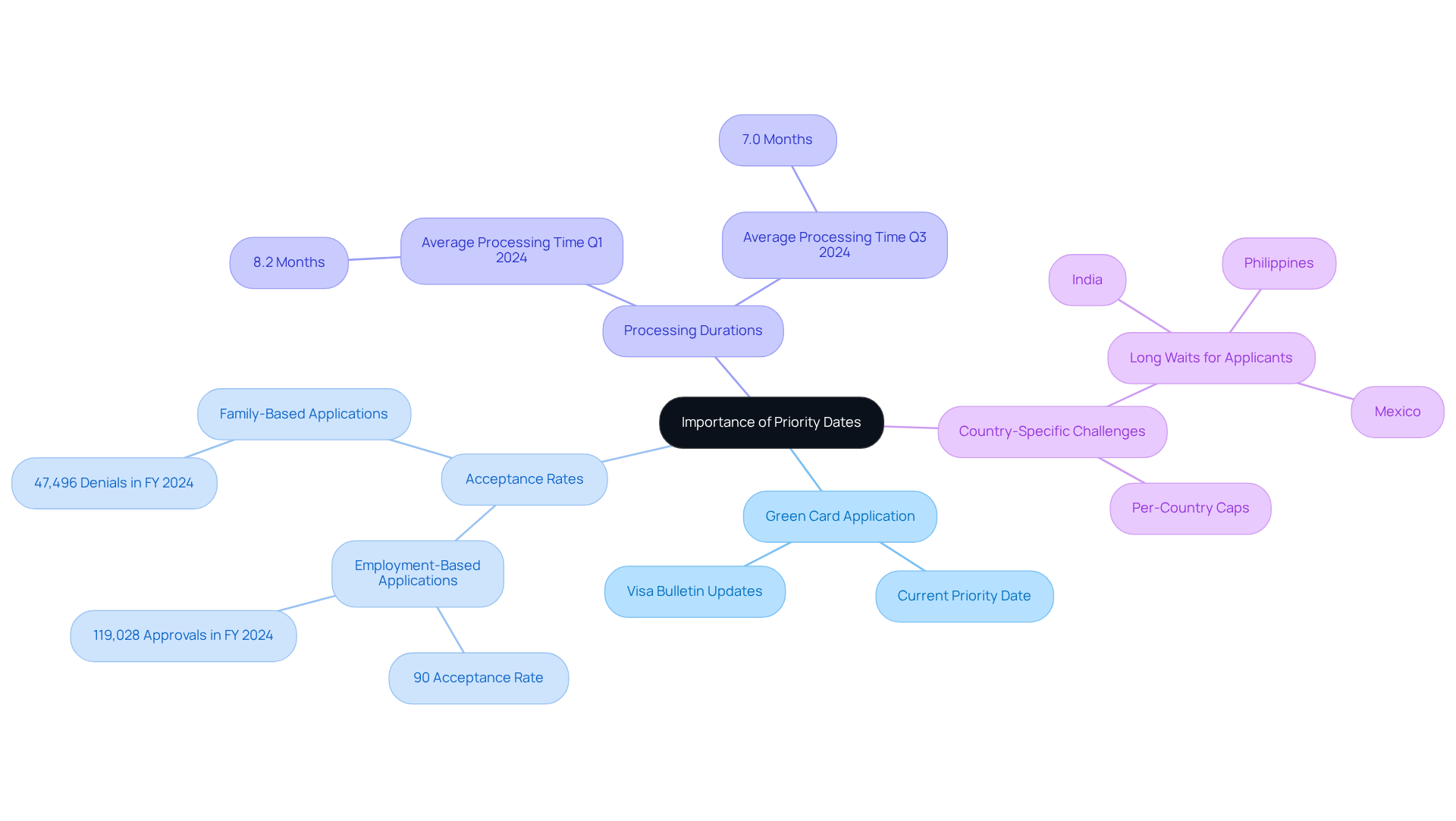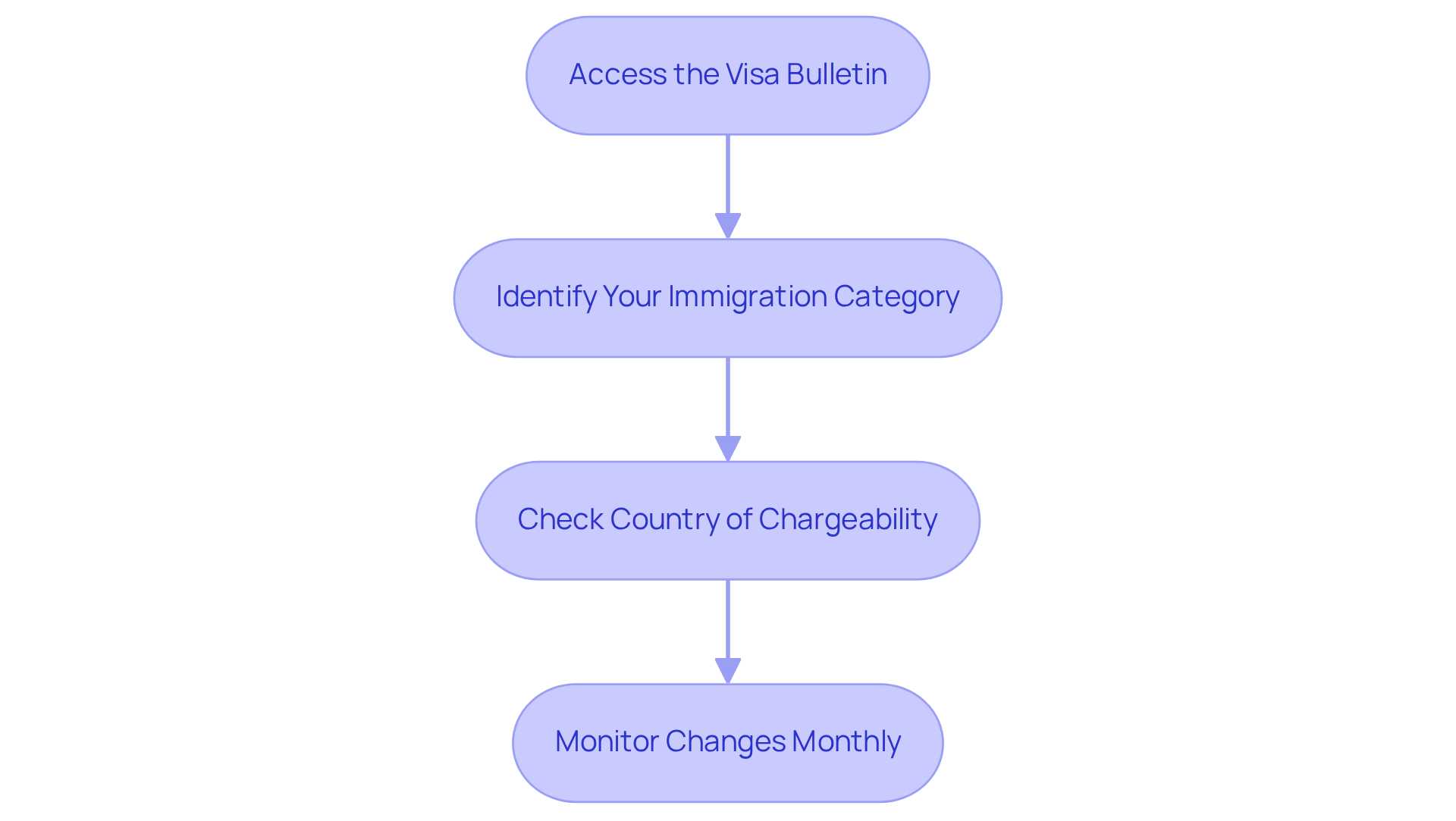Overview
The article focuses on the crucial role of green card priority dates in the U.S. immigration process. Priority dates are not just numbers; they determine when immigrants can apply for their green cards. Various factors—like country of origin and visa category—impact wait times, creating a complex landscape that can feel overwhelming. Real-world examples and processing statistics throughout the article illustrate these challenges, making the information relatable and actionable. It's essential to understand these dates, as they directly affect your path to residency. Remember, you’re not alone in this fight; we’re here to help you navigate the complexities of immigration with clarity and support.
Introduction
Understanding the intricacies of green card priority dates is crucial for immigrants navigating the U.S. immigration system. These dates dictate when individuals can apply for permanent residency and significantly impact their waiting times, especially in categories with annual visa limits.
We know how confusing this process can be, with complexities like processing times, retrogression, and fluctuating visa availability leaving many applicants feeling uncertain.
Have you ever felt lost in the immigration process? How can you effectively track and interpret these priority dates to ensure a smoother path toward obtaining a green card?
We’re here to fight for you.
Define Green Card Priority Dates
The moment an immigrant's petition reaches the U.S. is marked by Green Card Priority Dates. Citizenship and Immigration Services (USCIS). This moment is crucial—it determines an applicant's green card priority date in line for a green card, especially in categories with annual visa limits. For family-based immigration, the priority date is generally when USCIS receives the petition. However, for employment-based categories, this date can vary based on the labor certification process. Understanding the is essential for immigrants, as it has a direct impact on their wait time for permanent residency in the United States.
Processing times for various employment-based categories can significantly affect applicants. For instance, individuals from India often face lengthy delays in the EB-2 and EB-3 categories, with processing times stretching over several years. In FY 2024, the acceptance rate for employment-based green card applications was 90%, yet the average wait time for certain categories reached up to 16.2 months. This highlights the variability in processing times that many applicants must navigate.
Real-world scenarios illustrate how Priority Dates impact applicants' experiences. Those whose green card priority date is not current cannot advance to the final stages of the green card process, resulting in prolonged uncertainty. Immigration specialist Anne C. Miller emphasizes that the Visa Bulletin, published monthly by the Department of State, is a vital resource for tracking these dates. It helps applicants understand when they might expect to progress in their immigration journey, offering insights into the number of visas used, anticipated demand, and remaining authorizations under annual limits.
Moreover, understanding retrogression is key to grasping how the green card priority date can influence the timeline for obtaining a green card. Retrogression occurs when demand surpasses the available visas in a category or country, leading to delays that can last years or even decades. Therefore, the moment an immigrant submits their petition is not just a procedural step; it is a pivotal factor that shapes their path to acquiring a green card, particularly the green card priority date, impacting both their timeline and the overall experience of navigating the U.S. immigration system.

Explain the Importance of Priority Dates
Priority timelines, specifically the green card priority date, are essential as they determine when you can apply for a green card. If you're in a classification with restricted permits, like family-sponsored or employment-based categories, you must wait until your green card priority date is current. This is outlined in the Visa Bulletin issued monthly by the U.S. Department of State. A current green card priority date indicates that there are accessible visas for your category, allowing you to move forward with your application.
In FY 2024, the acceptance rate for employment-based applications stood at an impressive 90%, with 119,028 approvals out of 132,513 cases. This reflects a broader trend in the approval landscape that you should be aware of. Understanding the is crucial for managing your expectations and planning your next steps effectively.
Furthermore, the average processing durations for green cards were around 8.2 months in Q1 (Oct-Dec 2023) and 7.0 months in Q3 (Apr-Jun 2024). This information is vital as it informs you about the length of the application process. Keep an eye out for the Visa Bulletin updates for October 2025, as they will provide essential insights into the current status of the green card priority date timelines, influencing your application schedules and success rates.
It's important to note that individuals from countries such as India, Mexico, and the Philippines often face longer waits and procedural complexities, which can significantly impact their immigration journey. By examining case studies, it becomes evident that the green card priority date greatly influences the immigration process. Delays can affect not only personal applications but also broader patterns in permit availability and processing durations. Remember, you’re not alone in this fight—we’re here to support you every step of the way.

Discuss Factors Affecting Priority Dates
Navigating the green card application process can feel overwhelming. Priority dates, such as the green card priority date, are influenced by several key factors, including your country of origin, the specific permit category, and the ever-changing landscape of immigration policies. For example, individuals from countries with high demand for U.S. permits, like India and Mexico, often face long wait times due to significant backlogs. In FY 2024, family-sponsored preference permits were capped at 226,000 annually, while employment-based permits were limited to 140,000, intensifying competition for available slots.
The type of permit you apply for also plays a crucial role in how quickly your priority date advances. Family-sponsored immigrants often experience longer processing times compared to their employment-based counterparts, who generally enjoy higher approval rates thanks to clearer eligibility criteria. Take note: the average processing time for family-sponsored green cards peaked at 8.2 months in Q1 of FY 2024, fell to 5.2 months in Q2, and then rose again to 6.9 months in Q4, showcasing the fluctuations that can occur throughout the year.
Moreover, changes in U.S. immigration regulations can significantly affect permit availability and application processing. occurs when demand exceeds supply, resulting in cut-off dates that limit visa availability. This can lead to longer-than-expected waits for your green card priority date to become current, especially for applicants from oversubscribed countries, where backlogs can lead to substantial delays.
Understanding these dynamics is essential for anyone navigating the green card process. By staying informed about how your country of origin and permit type impact the green card priority date timelines, you can better plan your applications and anticipate potential setbacks. As M.E. Hammond aptly notes, "The trends behind green card statistics don’t just inform case strategy—they shape how law firms operate, grow, and serve clients." It's also important to recognize that immigrant permits for close relatives of U.S. citizens are unlimited and consistently available, providing a pathway without the same delays faced by other groups. Remember, you’re not alone in this fight—we’re here to support you every step of the way.

Guide on Checking and Interpreting Priority Dates
Navigating the complexities of immigration can be overwhelming. To stay informed about your timelines, make it a habit to regularly check the Visa Bulletin for your green card priority date on the U.S. Department of State's website. This bulletin is your roadmap, outlining the current timelines for various visa types and countries.
When you look at the bulletin, focus on your specific immigration category and country of chargeability. This will help you determine if your priority timeline is up-to-date. If it is, you can confidently move forward with your green card application.
Remember, it's essential to monitor any changes in the bulletin each month, as the green card priority date can fluctuate based on visa availability and demand. You're not alone in this fight—we're here to .

Conclusion
Understanding green card priority dates is essential for immigrants navigating the complex U.S. immigration system. These dates are pivotal in determining when applicants can move forward with their applications for permanent residency. The priority date, established when a petition is received by USCIS, significantly influences wait times and the overall experience for those seeking a green card, especially in categories with annual visa limits.
Throughout this article, we’ve discussed key insights, including how processing times can vary based on country of origin and visa category. For instance, individuals from countries with high demand, such as India and Mexico, often face longer wait times due to backlogs and retrogression. The Visa Bulletin is a critical resource for tracking priority dates and understanding when an applicant's date may become current. Additionally, the impact of immigration policies and the fluctuating nature of visa availability are significant factors influencing the green card application process.
In light of these complexities, it’s crucial for applicants to stay informed and proactive. Regularly checking the Visa Bulletin and understanding how priority dates affect individual circumstances can empower immigrants in their journey toward permanent residency. By recognizing the significance of these dates and the factors influencing them, applicants can navigate the immigration process more effectively and make informed decisions about their future in the United States. Remember, you’re not alone in this fight—we’re here to support you every step of the way.
Frequently Asked Questions
What is a Green Card Priority Date?
A Green Card Priority Date is the date when an immigrant's petition is received by the U.S. Citizenship and Immigration Services (USCIS). It is crucial as it determines the applicant's place in line for a green card, particularly in categories with annual visa limits.
How is the priority date determined for family-based and employment-based immigration?
For family-based immigration, the priority date is generally the date USCIS receives the petition. For employment-based categories, the priority date can vary based on the labor certification process.
Why is understanding the Green Card Priority Date important for immigrants?
Understanding the Green Card Priority Date is essential because it directly impacts the wait time for obtaining permanent residency in the United States.
What are the processing times like for employment-based green card categories?
Processing times for employment-based categories can vary significantly. For example, individuals from India often experience lengthy delays in the EB-2 and EB-3 categories, with average wait times reaching up to 16.2 months in FY 2024.
What happens if an applicant's Green Card Priority Date is not current?
If an applicant's Green Card Priority Date is not current, they cannot advance to the final stages of the green card process, resulting in prolonged uncertainty regarding their immigration status.
What is the Visa Bulletin and why is it important?
The Visa Bulletin is a monthly publication by the Department of State that helps applicants track their Green Card Priority Dates. It provides insights into the number of visas used, anticipated demand, and remaining authorizations under annual limits.
What is retrogression in the context of Green Card Priority Dates?
Retrogression occurs when the demand for visas exceeds the available supply in a category or country, leading to delays in the green card process that can last years or even decades.
How does the Green Card Priority Date influence the overall experience of navigating the U.S. immigration system?
The Green Card Priority Date is a pivotal factor in shaping an immigrant's path to acquiring a green card, affecting both their timeline and overall experience within the U.S. immigration system.




